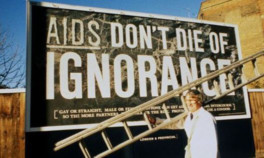HIV is no longer the death sentence it once was in the mid-80s and early 90s, according to a Tayside specialist.
Some 30 years ago the first newspaper reports emerged that the HIV virus had been identified in Tayside when two men tested positive.
The killer virus spread with alarming speed and by the early 90s Dundee had one of the highest levels of HIV infection among injecting drug misusers anywhere in Europe.
However, the introduction of needle exchanges and safe sex messages has greatly reduced the number of people being newly diagnosed with HIV in Tayside and Fife each year.
Sarah Allstaff, clinical lead for the sexual health service, said HIV is also now a “very treatable and manageable infection” and people receiving treatment can now live to old age.
Figures obtained under freedom of information legislation revealed 16 people tested positive for HIV in Tayside in 2013/14, a number that dropped to 13 in 2014/15.
In Fife last year 13 people tested positive for HIV, which was slightly up from nine 12 months previously.
Across both regions there was just one death attributed to Aids in the past two years, which was in Fife in 2014.
Dr Allstaff, who is a consultant in sexual health and HIV, said: “Newly diagnosed HIV rates are tailing off a little bit but I think it is important to say there are more people living with HIV than there have been up until now.
“One of the reasons for that is we have seen very few diagnoses from people who inject drugs, which was obviously one of the biggest risk groups back in the 1980s. We put that down to effective interventions such as providing needle exchanges.
“Secondly, for a long time in the 2000s, we were getting quite a lot of new diagnoses from people coming from outwith the UK and those numbers are coming down.
“However, the number of infections acquired by men who have sex with men continues to increase. That is a risk group that continues to see more and more infections. So, on the whole, infection rates seem to be coming down but within that risk group it is continuing to rise.
“We have a lot more people living with HIV. The treatment we give to people with HIV is worlds away from what we used to.
“People can be taking a single tablet once a day with very little side effects and can live normal lives plan families, have children, have relationships and live long enough to die of something else.
“Some studies show that people who are HIV positive can live as long as people who are HIV negative with a few caveats provided they are diagnosed early enough.”
Dr Allstaff said people not being diagnosed early enough remains a problem locally, which puts them at risk of getting ill and of the disease being passed on.
She said: “Although the outlook is very good, there is still work to be done to ensure people who have HIV are aware they have HIV in order to protect their own health as well as the health of others.”
Rapid tests which can lead to a diagnosis in 20 minutes are being given to the most high-risk groups in Tayside, with home testing kits allowing an early diagnosis like never before.
She said a cure was “very much” on the scientific agenda more than it has been in the past but still believes that will be many years away.
Aids first came to public attention in the UK in the early ‘80s and was followed by a widespread media campaign warning the public of the need for “safer sex.”
A leaflet was sent to every household in the country and the now notorious TV adverts featured tombstones and a grim reaper. Between 1985-86 and 1992-93, the government allocated more than £73 million to the development of the national Aids public education campaign.
NHS Fife’s clinical services manager for sexual health, Heather Bett, said: “While the numbers of those contracting HIV has reduced significantly from its peak, we still continue to see a small number of cases in Fife each year which could have been prevented.
“Coordinated prevention programmes have proven to be highly effective in increasing public awareness of the risk factors and initiatives such as needle and syringe exchange have reduced the spread of the illness among high-risk groups such as intravenous drug users.
“We have, however, seen an increasing prevalence over recent years in infections as a result of unprotected sexual contact, particularly among heterosexual men and men who have sex with men. It is incredibly important, therefore, that we guard against complacency and ensure we are acutely aware of the risks associated with unprotected sex.”
